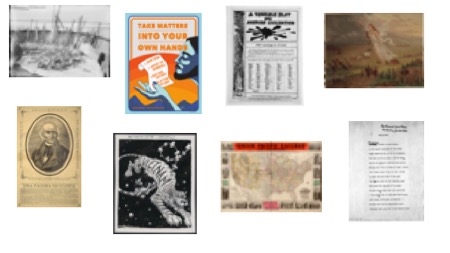Looking Back: Top Content of 2021

We were all hoping that 2021 would be easier than 2020 but the way it’s going out certainly wasn’t what we had been wishing for. That said, let’s look at the bright spots. More educators and students discovered and visited the Primary Source Nexus than the year before so we’re glad that highlighting great content from the Library of Congress and strategies and ideas for teaching with primary sources seems to have been helpful.
In 2021 we entered into a partnership with the National Education Association (NEA) to develop a series of micro-credentials. These professional development offerings are designed to help educators better integrate inquiry learning with primary sources into instruction across grades and disciplines using a variety of frameworks and strategies. Like all NEA micro-credentials, these professional development offerings are free for members and just $75 for non-members. We also have some vouchers for non-members so if you’d like one, use the contact form to send us a message with a valid school email address and a link to your faculty listing on the school website in the message section.
Currently, four TPS micro-credentials are under development and four are available now:
- Inquiry with Primary Sources
- Culturally Relevant Pedagogy with Primary Sources
- Multidisciplinary Civics with Primary Sources
- Universal Design for Learning with Primary Sources
These micro-credentials, rooted in developing educator practice, require just 15 hours to complete. In this time educators will adapt or create an activity or lesson that uses primary sources to engage students of all levels and backgrounds in inquiry, enhancing empathy, critical thinking, and content knowledge, skills, and dispositions. Access them today!
We also expanded the Citizen U Lesson Library. There are now links to nearly 200 multidisciplinary civics lessons for grades K-12. Every lesson includes tasks/activities using 1 or more primary sources from the Library of Congress, begins with a task/activity that sparks inquiry, often primary source analysis, follows up with tasks/activities to deepen inquiry through further student investigations, and concludes with a task/activity that has students applying their learning by taking action that makes contemporary/personal connections.
Be sure to check out the Teaching Now section, featuring innovative ideas for teaching with primary sources from the Library of Congress from amazing educators out in the field. If you have an activity or lesson you’d like to share, please don’t hesitate to contact us.
Below we link to our top 60 content for 2021 on the Primary Source Nexus. But, remember, there is so much more to discover. Click on the menu headers—Primary Sources, Learning Resources, Teaching Strategies, TPS & LOC.gov—or the colored section headers in the Browse Site Content box to uncover more. Another great way to find useful sources is to browse through the Themed-based Resources. You also won’t want to miss the Featured Sources section, which contains hundreds of guided primary source analysis activities for students in elementary school, middle school, and high school; consider using these to supplement a lesson, as bellringers, or as literacy skill practice.
We believe that learning with primary sources help students become information literate, a skill we all need if we are to be informed citizens. This skill is more important than ever today. We’re always interested to hear how you are teaching and learning with primary sources from the Library so if you have something to share or have a topic you would like to see highlighted, please contact us.
Kudos to all the educators and students out there for carrying on in amazing and inspiring ways. Here’s hoping, once again, for a happier and healthier New Year!
Primary Source Picks
- Marie Curie
- Dorothea Dix
- Amelia Earhart
- Alexander Hamilton
- Samuel Morse
- Harriet Tubman
- Harlem Hellfighters
- Iroquois Confederacy
- Little Rock Nine
- Tuskegee Airmen
- Wampanoag
- World War I Hello Girls
- American Revolution
- Civil Rights
- Covid-19 Coronavirus Pandemic
- Great Migration
- Harlem Renaissance
- Indian Removal
- Jazz Music
- Lynching
- Oregon Trail
- Race Riots/Protests
- Second Amendment & Gun Control
- Three-fifths Compromise & the Northwest Ordinance
- Western Expansion & Manifest Destiny
- Woman Suffrage
- Jan. 01: Ellis Island
- Jan. 14: Treaty of Paris
- Jan. 15: Martin Luther King, Jr.
- Jan. 23: Dr. Elizabeth Blackwell
- Feb. 23: Mexican-American War
- Mar. 10: Alexander Graham Bell
- May 10: Transcontinental Railroad Completed
- May 19: Siege of Vicksburg
- May 24: First Telegraphic Message Sent
- Jun. 19: Juneteenth
- Jun. 23: Texas Annexation
- Jun. 25: Custer’s Last Stand
- Jul. 11: Hamilton Burr Duel
- Jul. 20: The Seneca Falls Convention
- Jul. 30: Henry Ford
- Aug. 12: Thomas A. Edison
- Sep. 05: First Labor Day
- Sep. 08: The Galveston Storm
- Sep. 16: El Grito de Dolores – Mexican Independence Day
- Sep. 19: The Battles of Saratoga
- Sep. 20: Compromise of 1850
- Oct. 16: John Brown
Teaching & Learning
- Cartoonist Commentary-Vietnam War
- Comparing Reports of the Battle of Little Bighorn
- Primary Source Perspectives of the Civil War (Article resources)
- Primary Source Trail of Western Migration
Primary Source Learning
Featured Sources
Guided primary source analysis activities
